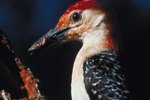
Green cheek conures (Pyrrhura molinae) are wee parrots from Bolivia, Paraguay, Brazil and Argentina. These birds have a strong presence in the wilds of their homelands; they're also often kept as beloved pets. Green cheek conures are known for their usually sweet but rather meek dispositions.
Basic Information
Green cheek conures usually grow no larger than 10 inches. Their plumage is mostly green, including on their cheeks. Their feathers also have blue, red and yellow elements. In nature, they're commonly found in rain forests. Because green cheek conures are on the small side and rather silent, as pets they often work well in environments that aren't uber-spacious -- apartments and condominiums, for example.
Wild Diet
In their native environments, green cheek conures consume several forms of sustenance. Some of their preferred foods are seeds, nectar and flowers. Ficus calyptroceras is a fig-bearing plant that green cheek conures often use for nourishment. Not only are these plants in the Moracceae family easy to find, they reliably produce fruit no matter what time of the year it is. However, green cheek conures visit many types of trees for feeding, whether they're going after dry fruit or pulp.
Captive Diet
As pets, green cheek conures often thrive when fed commercial pellets appropriate for their species. Speak to an avian veterinarian regarding suggestions for pellets, and make sure that they are beneficial for the exact species. Fresh fruit and vegetables also are helpful additions to green cheek conure food plans. Bananas, dandelions, kale, pears, romaine lettuce, apples, green beans, celery, carrots, Swiss chard and peas are good examples. In small amounts, occasional fortified seeds also can work well. As rare treats, tiny pieces of hard cheese can be positive elements, too. If you're not 100 percent sure that a food item is right for your conure, don't feed it to him until you ask a veterinarian. Safety always comes first.
Water in the Diet
Just like people, green cheek conures require ample hydration to stay healthy, happy and alert. Make sure your parrot always has easy access to plentiful and clean H20. Water that is filtered is optimal for these conures. Refresh and replenish your pet's water supply at least once daily. With the right care -- and this includes proper feeding -- green cheek conures can live a maximum of 30 years or so.
References
- BirdChannel.com: The Popular and Playful Green-Cheeked Conure
- BirdChannel.com: Green-Cheeked Conure Birds
- World Parrot Trust: Green-Cheeked Conure -- Care in Captivity
- International Union for Conservation of Nature Red List of Threatened Species: Pyrrhura Molinae
- Scielo Brazil: Feeding Ecology of the Green-Cheeked Parakeet in Dry Forests in Western Brazil
Photo Credits
-
Brand X Pictures/Brand X Pictures/Getty Images


